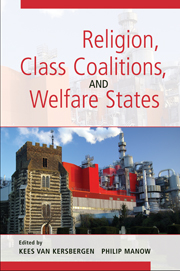Book contents
- Frontmatter
- Contents
- Preface
- List of Contributors
- 1 Religion and the Western Welfare State – The Theoretical Context
- 2 Western European Party Systems and the Religious Cleavage
- 3 The Religious Foundations of Work-Family Policies in Western Europe
- 4 Italy: A Christian Democratic or Clientelist Welfare State?
- 5 Religion and the Welfare State in the Netherlands
- 6 A Conservative Welfare State Regime without Christian Democracy? The French État-Providence, 1880–1960
- 7 Religion and the Consolidation of the Swiss Welfare State, 1848–1945
- 8 The Church as Nation? The Role of Religion in the Development of the Swedish Welfare State
- 9 The Religious Factor in U.S. Welfare State Politics
- 10 Religious Doctrines and Poor Relief: A Different Causal Pathway
- Index
6 - A Conservative Welfare State Regime without Christian Democracy? The French État-Providence, 1880–1960
Published online by Cambridge University Press: 28 January 2010
- Frontmatter
- Contents
- Preface
- List of Contributors
- 1 Religion and the Western Welfare State – The Theoretical Context
- 2 Western European Party Systems and the Religious Cleavage
- 3 The Religious Foundations of Work-Family Policies in Western Europe
- 4 Italy: A Christian Democratic or Clientelist Welfare State?
- 5 Religion and the Welfare State in the Netherlands
- 6 A Conservative Welfare State Regime without Christian Democracy? The French État-Providence, 1880–1960
- 7 Religion and the Consolidation of the Swiss Welfare State, 1848–1945
- 8 The Church as Nation? The Role of Religion in the Development of the Swedish Welfare State
- 9 The Religious Factor in U.S. Welfare State Politics
- 10 Religious Doctrines and Poor Relief: A Different Causal Pathway
- Index
Summary
INTRODUCTION
In many respects, the French welfare state resembles the Bismarckian blueprint of a conservative regime type: wage-deducted contributions and wage-related benefits, a fragmentation of social insurance schemes along occupational lines, and the predominance of funds (caisses) managed according to principles of self-administration (gestion par les intéressés, démocratie sociale), with the prominent participation of unions. The French É tat-providence also shares many of the problems that plague the continental welfare state today: runaway costs; adverse labor market effects due to high nonwage labor costs leading to poor job growth, especially in low productivity services; and low employment ratios as a result of generous early retirement schemes. Like its continental counterparts, the French welfare state is also often perceived as being ‘immovable’ and ‘frozen’ because it largely resists any political attempts at reform (but see Palier 2000).
In the comparative literature, the French welfare state has usually been classified as a conservative, continental, Catholic, or Bismarckian regime (Esping-Andersen 1990; Huber et al. 1993; Huber and Stephens 2001; Scharpf and Schmidt 2001; Palier and Martin 2007). However, it sits somewhat uneasily with this classification. In fact, the French Étatprovidence is not particularly conservative, patriarchic, or Catholic when it comes to family policy (Morgan 2002, 2003, Chapter 3, this volume; Talmy 1962), and its strong emphasis on universal social assistance has a much more ‘Beveridgian’ than ‘Bismarckian’ flavor to it (Levy 2000: 312–313).
- Type
- Chapter
- Information
- Religion, Class Coalitions, and Welfare States , pp. 146 - 175Publisher: Cambridge University PressPrint publication year: 2009
- 4
- Cited by



